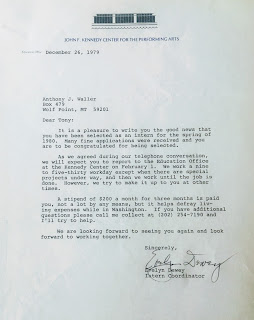As a college senior I spied a bulletin board notice: Kennedy Center Internships. The Kennedy Center for the Performing Arts, Washington, DC, send out the notices to over 300 colleges in 1979, including Montana State University. I put my entire effort into my application, now realizing that my childhood and background was lacking. They sent a nice letter back, saying that I was not selected but I had been a runner up and should someone drop out I would be contacted. It was like saying "thank you" but don't call.
I have always possessed tenacity, a sense of persistence that was beyond my control. I proceeded to write to both of my US Senators and Congressmen (at that time Montana had two Congressmen). I told them about the internship program and figured out how to visit the Kennedy Center offices that summer in Washington. My letters and visit caused a stir and even the Dean for the College of Arts and Architecture was wondering what I was up too. In the end, I think the Kennedy Center, Intern Coordinator, Evelyn Dewey was willing to have me be an intern, just to stop the commotion.
Intern Acceptance Letter
Signed by Evelyn Dewey
I started my internship in February 1980, and was assigned to Bennett Tarleton, at that time the Kennedy Center Director, Alliance for Arts Education Network. The Network is a coalition of statewide not-for-profit arts educations programs that support policies, practices and partnerships that enhance K-12 arts education in the United States. Also as part of the Kennedy Center's Arts Education operation was the Very Special Arts, a multifaceted program designed to provide art opportunities to disabled youth. The Very Special Arts was started and in those days Jean Kennedy Smith, the sister of the former President, oversaw the program. Likewise, it was common to see Eunice Kennedy Shriver and Senator Ted Kennedy at the Center. The broader Kennedy family visited often.
During my internship I sat in a wide hallway between two offices, The Alliance of Arts Education and the American College Theatre Festival operation. The ACTF was having way more fun than AAE. Dr. David Young was the Producing Director for the Kennedy Center ACTF at that time, a national theater program dedicated to the improvement of collegiate theater in the United States. Now it involves students from more than 600 colleges and universities throughout the country. The annual Theatre Festival included a lot of errands and coordinating, and I was good at chasing down college instructors and students and getting them to the right place at the right time.
Every year before the Festival, the current US President would send a welcoming letter to all the participating Colleges and Universities. The letters were framed and hung in the conference room. I am sure that most President's never saw their letters to these budding actors, however someone at the White House came up with several lines of well wishes, and had it auto-penned and sent it over to the Center. As I tell this story, there was one office policy; right after any of the Kennedy sisters left the office, the conference wall was to be checked and inspected. The letters from President Richard Nixon would be removed and found in the trash, and they needed to be found and rehung before the trash was picked up during the evening rounds. It was a game that was played for years between the Kennedy family and the staff.
Somehow, I ended up by helping out that year with the Theatre Festival. From that point on for the next ten years I served as an assistant stage manager for what could be described as the "College Tony Awards" for the Festival - "The Winners' Circle Evening of Scenes".
Those yearly events provided the opportunity to interact with some of Hollywood's and Broadway's greats. Each year would include a celebrity that appeared on stage with introductory remarks, and then present the winners with their scholarships. My first celebrity was Dina Merill, a famed actress of the 1950s and 1960s. Her mother was Marjorie Merriweather Post (the Post Cereal Company and owner of General Foods) and her father was a successful stockbroker. Ms. Merill had grown up at Mar-a-Lago way before President Trump had considered purchasing the grand-estate. I remember her as tall, very attractive, sophisticated and kind.
Other years included Richard Thomas, who was "John Boy" on The Waltons. He was as smooth as as it could get and unpretentious. You would not have believed he was a celebrity if you didn't know. One year included the famed Don Johnson, who played James "Sonny" Crockett on Miami Vice. I tried to play a part of his security detail, but at 5'-4" I was not very good at it. And of course there was Cicely Tyson, who played the roles of strong African American women. She came with her own tall escort, perhaps a body-guard.
Broadway included Patti Lupone, Grammy and Tony Award winner, the star of Sunset Boulevard and Evita, just to name two. She was spunky and fun. All totaled, my job was nothing more than to know the Kennedy Center building, the backstage, the dressing rooms, and make sure the green room was perfect for the stars. I held famous ladies' purses, and famous men's jackets, and kept track of the staff and the college actors.
Kennedy Center Stagebills
from my years of being an
Assistant Backstage Mgr.
from my years of being an
Assistant Backstage Mgr.



Love this!
ReplyDelete